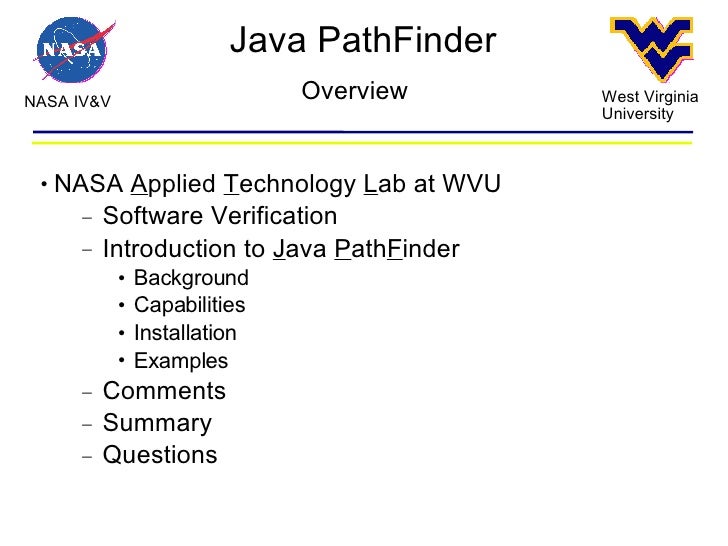

JPF will only enumerate the inputs for small ranges of values. An example would be assert3 in the jbmc-regression suite where an error occurs when the input satisfies the constraint \(i \ge 1000 \wedge i \le 1000\).
#Java path finder full#
It is therefore also unsurprising that JPF did poorly in some cases where a constraint solver is required to analyze the full state space effectively. In this case, the state space is small enough that an exhaustive search is easy, and there is no need to track path conditions (which are implemented by the Symbolic Pathfinder extension ). Furthermore, native peers have access to low-level data structures inside the JPF VM, and thus can read and modify the state of model classes or any other classes that are managed by the JPF VM.Īs expected, JPF performed very well on examples with simple non-deterministic inputs such as Boolean parameters. This means that any built-in library functionality (such as I/O) is available to native peer classes. To achieve this, JPF supports native peer classes, which are executed directly on the host VM. Sometimes, though, it is necessary to access native code, for example, to perform input/output. Such model classes are fully managed by JPF. With this mechanism, a class with native methods can be replaced with a Java-based model class that does not use native code. To overcome this limitation, JPF allows model classes to be defined, which replace the standard library classes with custom code. Changes to memory by native methods, or other side effects thereof, are not visible to JPF.
#Java path finder code#
However, this approach cannot handle native methods, which execute unmanaged code (written in C or C++) that is not supervised by JPF. This allows JPF to capture the full address space of the program, and revert any changes in memory when backtracking the state of the SUT during the state space search.

The system under test (SUT) is run inside the JPF VM, and cannot directly interact with the host VM. Java Pathfinder itself is written in Java and therefore runs on the standard JVM, called host JVM (see Fig. In the context of SV-COMP, symbolic inputs were always treated as entirely non-deterministic choices when using jpf-core.
#Java path finder verification#
Note that both the hash-compaction and the implementation of partial-order reduction (JPF group instructions that can only have a local effect into the same transition, but this is based on heuristics) used can cause behaviours to be missed during analysis and for this reason JPF is only a bug-finding tool, not a verification tool.Īt its core, JPF treats any source of non-determinism as a choice common choices are scheduling choices and non-deterministic choices over a range of values, e.g., whether a network is available or not . Another optimization to allow for the efficient analysis of concurrent programs is a form of partial-order reduction that groups bytecode together in a transition as long as they cannot have any visible effect on other threads. Additionally a fingerprint of each state of the JVM (using hash-compaction ) is stored to allow state-matching and to keep the analysis linear in the size of the state-space of the program being analyzed. This component supports functionality for executing bytecode as well as backtracking over already executed code. main architectural component of JPF is a Java virtual machine (JVM), implemented in Java. and I also want to ask that is this a best solution to find a shortest path in this scenario or something else ? import so I want guidance that what steps should I have to take to make it run able for n x n matrix. I write this code with the help of an algorithm from my book, actually now I want to make it dynamic that means for n x n matrix. the black boxes are obstacles and we can't go to it and the blue box is the starting point and the yellow box is the end point I want to go from starting point to end point. I want to find the path from one point to another point.


 0 kommentar(er)
0 kommentar(er)
